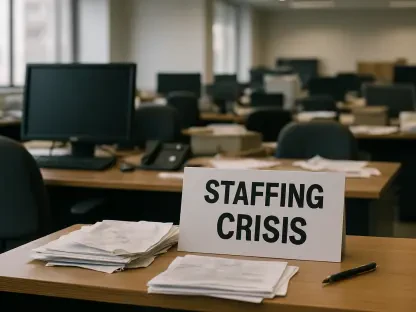Today, we’re thrilled to sit down with Sofia Khaira, a renowned specialist in diversity, equity, and inclusion, who has dedicated her career to transforming talent management and development practices. With a passion for creating inclusive and equitable workplaces, Sofia offers a wealth of insights into the evolving challenges and opportunities in HR. In this conversation, we dive into pressing issues like funding constraints in recruitment, prolonged hiring timelines, future hiring trends, employer confidence in talent acquisition, and the growing reliance on temporary and freelance workers. Join us as we explore her expert perspective on navigating these complex dynamics.
How do you think budget shortages are affecting the recruitment landscape, especially with over half of recruiters struggling to secure adequate funding?
Budget shortages are creating a real bottleneck for recruiters. Often, these constraints stem from broader economic uncertainty or competing priorities within organizations where HR budgets get squeezed. I’ve seen companies forced to scale back on critical tools, advertising, or even headcount for recruitment teams. This can lead to a vicious cycle—less investment means slower hiring, which delays filling roles and impacts business outcomes. It’s a tough spot, and it pushes HR leaders to get creative with limited resources.
What impact have you noticed these funding issues having on the hiring processes of organizations you’ve worked with?
The impact is palpable. I’ve worked with organizations where funding cuts have led to overburdened HR teams juggling multiple roles, which slows down everything from candidate sourcing to onboarding. Some companies can’t afford premium job boards or advanced applicant tracking systems, so they rely on manual processes that eat up time. Worse, it often means settling for less qualified candidates because there’s no budget for extended searches or competitive offers. It’s a compromise that can hurt long-term growth.
Can you share some strategies that have proven effective in maximizing limited recruitment budgets?
Absolutely. One approach I’ve seen work well is leveraging internal mobility—promoting or reskilling existing employees to fill open roles instead of external hiring. It saves on recruitment costs and boosts morale. Another is focusing on employer branding through low-cost channels like social media to attract talent organically. Skills-based hiring is also key; using objective assessments upfront can filter candidates efficiently without breaking the bank. It’s about working smarter, not just harder.
What do you believe are the main factors contributing to the average time-to-hire increasing from under five weeks to eight weeks?
Several factors are at play here. First, budget constraints often mean fewer resources for streamlined processes, so screening and interviewing take longer. There’s also a growing caution among employers to avoid bad hires, leading to more rigorous vetting—sometimes overly so. Additionally, candidates are taking longer to accept offers, often waiting for multiple opportunities in a competitive market. It’s a combination of operational inefficiencies and a shift in market dynamics that’s dragging out timelines.
How does a prolonged hiring timeline affect a company’s ability to remain competitive or achieve its goals?
It’s a significant setback. When roles stay vacant for weeks, projects stall, workloads pile up on existing staff, and morale can take a hit. I’ve seen companies lose out on top talent because competitors moved faster with offers. In fast-paced industries, an eight-week delay can mean missing market opportunities or failing to scale at the right time. It’s not just an HR issue—it ripples through the entire organization, impacting productivity and growth.
What tools or approaches have you found helpful in reducing time-to-hire despite these challenges?
One game-changer is using data-driven tools like skills assessments early in the process to quickly identify strong candidates without endless resume reviews. I also advocate for clear, well-written job descriptions to attract the right people from the start, minimizing back-and-forth. Streamlining interview stages—say, combining initial screenings into one round—can shave off days or weeks. And don’t underestimate the power of a strong employer brand; it draws candidates in faster, reducing sourcing time.
With many large firms and SMEs planning to increase hiring next year, what do you think is fueling this optimism?
I think it’s a mix of recovery from economic uncertainty and a recognition of pent-up demand for talent. Many companies delayed hiring during tougher times and now see the need to scale up to meet growth targets. There’s also a push to future-proof workforces by bringing in skills for emerging areas like tech or sustainability. This optimism reflects a belief that the market is stabilizing, and businesses are ready to invest in people as a key driver of success.
How do you see this planned hiring surge influencing competition for talent across industries?
It’s going to heat up, no question. With more firms vying for the same pool of candidates, we’ll see bidding wars for top talent, especially in high-demand fields. Smaller companies might struggle against larger ones offering bigger salaries or perks. It could also push organizations to differentiate through culture, flexibility, or purpose-driven missions. The competition will force everyone to up their game, but it risks leaving some sectors or smaller players short-handed if they can’t keep pace.
What advice would you give to smaller businesses trying to attract candidates when competing with larger firms?
Smaller businesses need to play to their strengths. Highlight agility and personal impact—candidates often value knowing their work matters in a smaller setting. Offering flexible work arrangements or unique growth opportunities, like cross-functional exposure, can be a draw. Building a strong, authentic culture and showcasing it through employee stories on social platforms can also make a big difference. It’s about creating a compelling narrative that big budgets can’t replicate.
Despite the challenges, a majority of employers feel confident in securing the talent they need. What do you think is driving this confidence?
I believe it comes from a growing adaptability among employers. Many have learned to pivot during tough times, whether through remote hiring, tapping into freelance talent, or upskilling current staff. There’s also a sense that the talent pool is diversifying—more candidates are open to varied roles or industries. Confidence likely stems from having navigated past crises and feeling equipped with strategies to handle current ones, even if the road isn’t smooth.
Do you personally share this confidence, or are there larger obstacles you foresee in finding the right talent?
I’m cautiously optimistic. While I see the resilience and innovation in HR practices, I’m concerned about persistent skills gaps in critical areas and the mismatch between candidate expectations and what companies can offer, especially with tight budgets. There’s also the challenge of ensuring diversity and inclusion in hiring, which can get sidelined under pressure. I think we can find talent, but it requires sustained effort and a willingness to rethink traditional approaches.
How can companies sustain or build confidence in their talent acquisition efforts, especially in a tough market?
It starts with a strong foundation—clear hiring strategies aligned with business goals. Investing in data-driven insights to understand where talent is and what they want helps avoid guesswork. Fostering a positive candidate experience, even with rejections, builds a reputation that draws people in. And don’t overlook internal talent; upskilling and mobility programs can fill gaps while boosting confidence that you’re not entirely reliant on external hires. It’s about control and adaptability.
Why do you think so many businesses are increasingly turning to temporary workers and freelancers in recent months?
It’s largely about agility and cost control. In uncertain times, companies want flexibility to scale up or down without the fixed costs of full-time hires. Freelancers and temporary workers allow firms to access specialized skills for short-term projects without long-term commitments. There’s also a cultural shift—many workers prefer gig roles for variety or autonomy, so the supply matches the demand. It’s a strategic move to stay nimble while managing budgets.
What are some of the key benefits and challenges of relying on temporary or freelance talent compared to full-time employees?
The benefits are clear: cost savings on benefits and overhead, access to niche expertise, and the ability to pivot quickly based on workload. However, challenges include a lack of long-term loyalty or institutional knowledge, which can hurt continuity. There’s also the risk of misclassification or compliance issues if contracts aren’t managed properly. And culturally, integrating temporary workers into teams can be tricky—they might not feel as invested, which impacts collaboration.
How can HR teams ensure they’re managing temporary and freelance workers effectively, especially when it comes to compliance?
It’s critical to have robust systems in place. Start with clear contracts that define scope, duration, and classification to avoid legal pitfalls. Use technology to track hours and deliverables for transparency. Training managers on how to onboard and engage contingent workers helps with integration. Regular audits of compliance with labor laws are a must—missteps can be costly. And don’t forget communication; keeping these workers in the loop builds trust and ensures alignment with company goals.
What is your forecast for the future of recruitment strategies given these evolving challenges and trends?
I see recruitment becoming even more strategic and tech-driven. We’ll likely see greater reliance on AI and data analytics to streamline processes and predict candidate fit, especially as budgets remain tight. Hybrid models blending full-time, freelance, and internal talent will become the norm to balance cost and flexibility. I also expect a stronger focus on diversity and inclusion as a competitive edge in attracting talent. The future is about adaptability—those who embrace change and invest in people, even modestly, will come out ahead.









